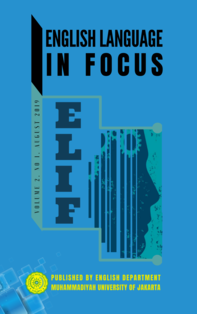The Effectiveness of Using Collaborative Strategic Reading (CSR) on Students’ Reading Comprehension of Narrative Text
DOI:
https://doi.org/10.24853/elif.2.1.53-58Keywords:
collaborative strategic reading (CSR), narrative text, reading comprehension.Abstract
This study aimed to find out whether or not the use of collaborative strategic reading (CSR) will be effective on students’ reading comprehension of narrative text. The study used a quantitative method with pre-experimental design. The instruments used in this study were pre-test and post-test and the subjects of this study were the tenth-grade students of MA Annida Al-Islamy. The data were analyzed by using the t-test. The results showed that the students mean score in pre-test was 64 while in post-test mean score was 78. The result of this study analysis obtained 8.439 to and 2.045 tt with significant of 5%. Thus, it can be said that the use of collaborative strategic reading (CSR) on students’ reading comprehension of narrative text was effective.References
Andanawati, D. (2013). The Use of Collaborative Strategic Reading (CSR) in Reading Comprehension. Bandung: Universitas Pendidikan Indonesia. Unpublished Thesis.
Anderson, M., & Anderson, K. (2010). Text Types in English 3. Australia: Macmillan Education Australia.
Fraenkel, J. R., & Wallen, N. E. (2011). How to Design and Evaluate Research in Education. New York: McGraw-Hill.
Grabe, W., & Stoller, F. L. (2011). Teaching and Researching Reading. New York : Routledge.
Klingner, J. K., Vaughn, S., & Boardman, A. (2015). Teaching Reading Comprehension to Students with Learning Difficulties. New York: Guilford Publications.
McDonough, J., & Shaw, C. (2012). Materials and Methods in ELT: A Teacher’s Guide. Wiley: Blackwell Pub.
Snow, C. E. (2012). Reading for Understanding: Toward an R&D Program in Reading Comprehension. United States: RAND Corporation.
Downloads
Published
Issue
Section
License
Authors who publish with this journal agree to the following terms:
- Authors retain copyright and grant the journal right of first publication with the work simultaneously licensed under a Creative Commons Attribution License that allows others to share the work with an acknowledgment of the work's authorship and initial publication in this journal.
- Authors can enter into separate, additional contractual arrangements for the non-exclusive distribution of the journal's published version of the work (e.g., post it to an institutional repository or publish it in a book), with an acknowledgment of its initial publication in this journal.
- Authors are permitted and encouraged to post their work online (e.g., in institutional repositories or on their website) before and during the submission process, as it can lead to productive exchanges, as well as earlier and greater citation of published work (See The Effect of Open Access).


